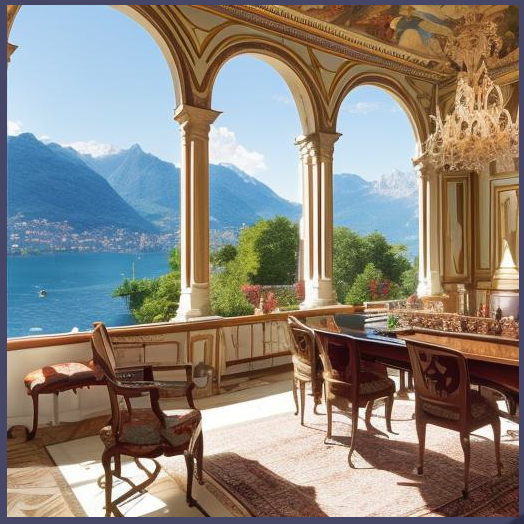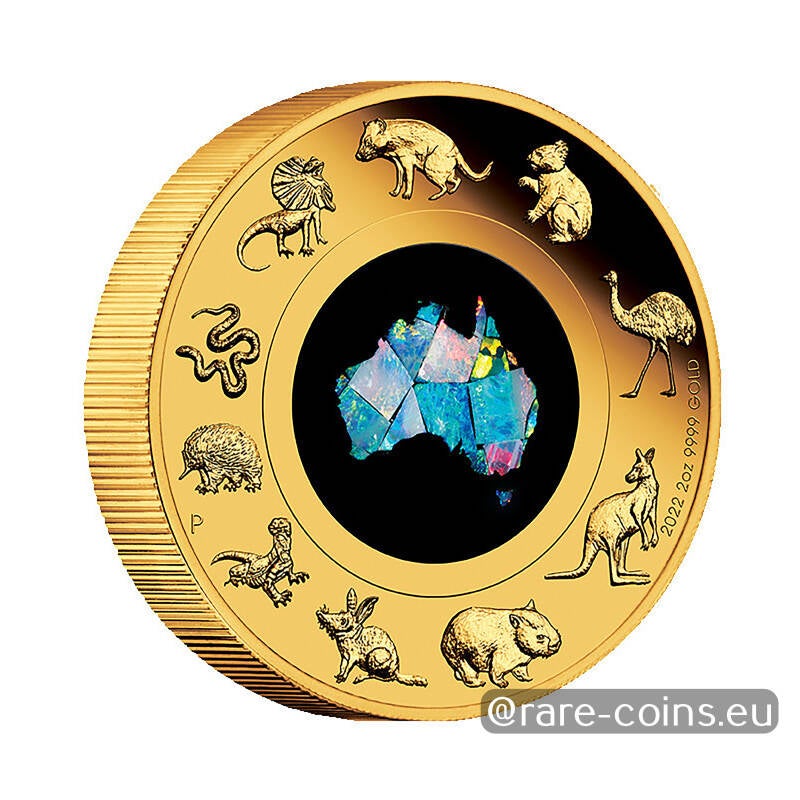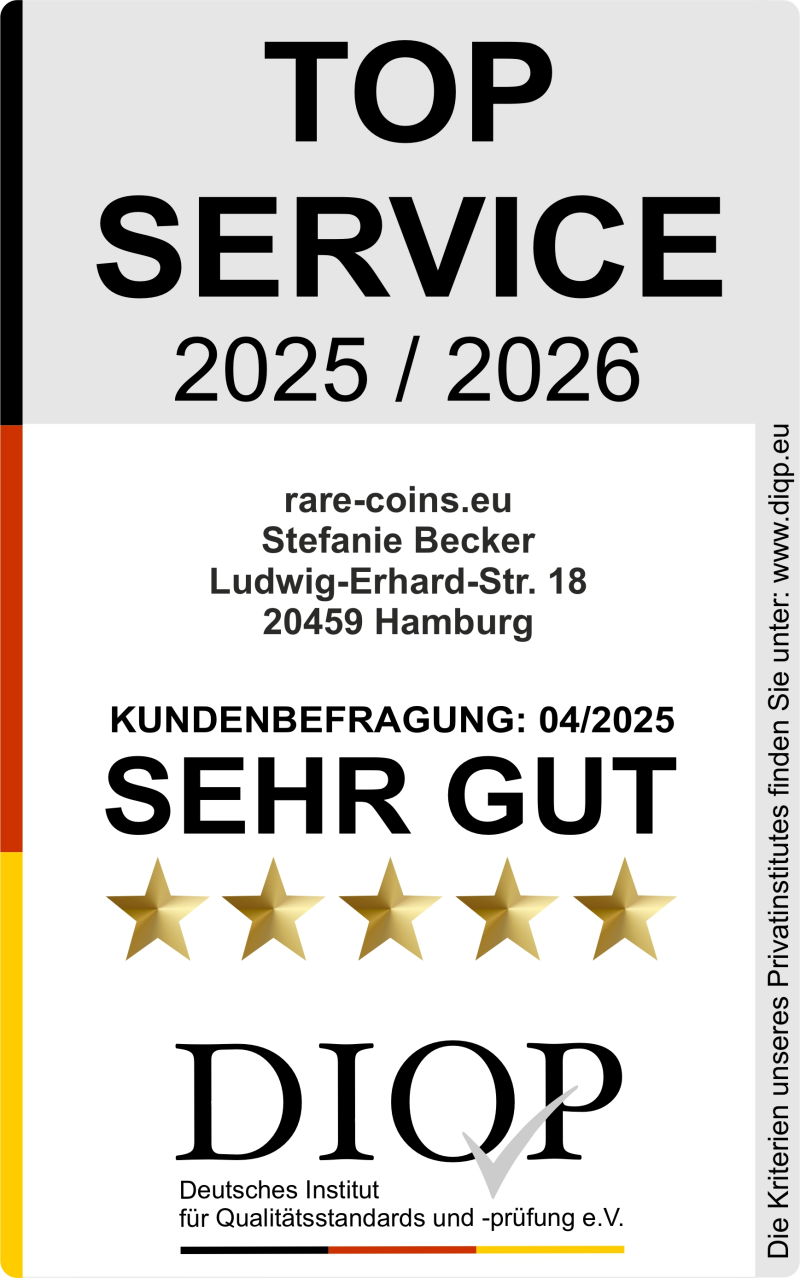Link zu unserem Ebay-Shop: www.ebay.de/str/rarecoinseu
Prince-Gallery – Seltene Münzen und moderne Kunst, die Werte bewahren
Willkommen in der Prince-Gallery, einem Ort, an dem Sammlerstücke mehr sind als bloße Objekte. Hier begegnen sich die glänzende Welt seltener Münzen und die farbenreiche Vielfalt der modernen Kunst. Zwei Leidenschaften, die auf den ersten Blick unterschiedlich erscheinen, entfalten zusammen eine einzigartige Kraft: Sie erzählen Geschichten, bewahren Werte und schenken Inspiration.
Die Münzkollektion der Prince-Gallery ist ein Tor in vergangene Epochen und zugleich ein Spiegel unserer Gegenwart. Jede Gold- oder Silbermünze trägt ein Stück Geschichte in sich – ob sie an historische Ereignisse erinnert, majestätische Tiermotive zeigt oder durch feinste Gravuren besticht. Es sind Raritäten, die nicht nur Sammlerherzen höherschlagen lassen, sondern auch Sicherheit und Wertstabilität in unruhigen Zeiten versprechen. Wer eine seltene Münze in den Händen hält, spürt, dass hier nicht nur Metall, sondern ein Stück Kultur in seiner reinsten Form bewahrt wird.
Doch die Galerie lebt nicht allein vom Glanz der Edelmetalle. Ebenso bedeutend ist die Sammlung außergewöhnlicher Gemälde der Modern Art, die in ihrer Ausdruckskraft den Blick weiten und Emotionen wecken. Jedes Bild ist ein Unikat, eine Geschichte in Farbe, die zum Nachdenken, Staunen und Verweilen einlädt. Manche Werke sprechen in kräftigen Tönen, andere flüstern in zarten Linien – doch alle eint die Fähigkeit, Räume zu verwandeln und Herzen zu berühren.
Unsere Mission ist es, diese beiden Welten miteinander zu verbinden: das beständige Sammeln seltener Münzen und das emotionale Erleben moderner Kunst. Wir glauben, dass wahre Sammlerstücke nicht nur einen materiellen, sondern vor allem einen ideellen Wert haben. Sie sind Brücken zwischen Vergangenheit und Zukunft, zwischen Substanz und Inspiration.
Die Prince-Gallery ist damit weit mehr als ein Onlineshop. Sie ist ein Ort der Leidenschaft, an dem Menschen ihre Sammelträume verwirklichen können. Wer hier stöbert, sucht nicht nur nach einer Münze oder einem Gemälde – er begibt sich auf eine Reise, bei der Geschichte, Kunst und persönliche Leidenschaft ineinandergreifen.
Ob Sie sich für eine seltene Goldmünze interessieren oder nach einem modernen Gemälde suchen, das Ihr Zuhause bereichert: In der Prince-Gallery finden Sie beides. Unser Ziel ist es, Sammlerinnen und Sammler nicht nur mit Raritäten zu begeistern, sondern ihnen Werte an die Hand zu geben, die bleiben. Denn Kunst und Numismatik sind mehr als Besitz – sie sind ein Stück Identität, ein Ausdruck dessen, was uns berührt und was wir für die Zukunft bewahren wollen.
Beginnen Sie Ihre Reise hier, in der Prince-Gallery – dort, wo glänzende Münzen und lebendige Kunstwerke eine gemeinsame Sprache sprechen.




Prince-Gallery: Exclusive gold & silver coins, numismatic rarities, and extraordinary works of Modern Art. Discover treasures with lasting value.
Welcome to Prince-Gallery, a place where collectibles are more than just objects. Here, the shining world of rare coins meets the colorful diversity of modern art. Two passions, seemingly different, unfold a unique power when brought together: they tell stories, preserve values, and inspire.
Our coin collection opens the door to past eras while reflecting the present. Each gold or silver coin carries a piece of history – whether it recalls historic events, depicts majestic animals, or impresses with its finest engravings. These rarities not only excite collectors but also offer security and value stability in uncertain times. Holding a rare coin is like holding culture in its purest form.
But our gallery is not only about precious metals. Equally important is our collection of extraordinary modern artworks that widen your perspective and stir emotions. Each painting is unique – a story told in color, inviting you to pause, reflect, and be inspired. Some works speak in bold tones, others whisper in delicate lines – yet all have the power to transform spaces and touch hearts.
Our mission is to connect these two worlds: the lasting value of rare coins and the emotional depth of modern art. True collectibles are not only valuable possessions; they are bridges between past and future, between substance and inspiration.
Prince-Gallery is more than an online shop. It is a place of passion, where collectors can fulfill their dreams. Those who explore here embark on a journey where history, art, and personal passion come together.
Whether you are looking to invest in a rare gold coin or discover a modern painting for your home – at Prince-Gallery you will find both. Our goal is to offer pieces that inspire, endure, and express identity. For us, art and numismatics are more than possessions – they are part of who we are, and what we want to preserve for the future.
ميتا العنوان
Prince-Gallery | عملات نادرة وفن معاصر عبر الإنترنت
ميتا الوصف
Prince-Gallery: عملات ذهبية وفضية حصرية، نوادر نقدية، ولوحات فنية استثنائية من الفن الحديث. اكتشف كنوزاً خالدة ذات قيمة دائمة.
نص الصفحة الرئيسية
مرحبًا بك في Prince-Gallery، حيث تكون المقتنيات أكثر من مجرد أشياء. هنا يلتقي عالم العملات النادرة المتألقة مع تنوع الفن الحديث المليء بالألوان. شغفان يبدوان مختلفين للوهلة الأولى، ولكنهما معًا يكشفان عن قوة فريدة: قوة تحكي القصص، وتحافظ على القيم، وتلهم الروح.
تفتح مجموعتنا من العملات بابًا إلى عصور مضت وتعكس في الوقت نفسه حاضرنا. كل عملة ذهبية أو فضية تحمل جزءًا من التاريخ – سواء كانت تخلّد أحداثًا تاريخية، أو تعرض حيوانات مهيبة، أو تبهر بتفاصيلها الدقيقة. هذه النوادر لا تجذب الجامعين فقط، بل تمنح أيضًا شعورًا بالأمان واستقرارًا في القيمة في أوقات عدم اليقين. امتلاك عملة نادرة هو امتلاك قطعة من الثقافة في أنقى صورها.
لكن معرضنا لا يقتصر على المعادن الثمينة. فالمجموعة الخاصة من اللوحات الفنية الحديثة لا تقل أهمية، فهي توسع الآفاق وتوقظ المشاعر. كل لوحة فريدة – قصة مرسومة بالألوان تدعوك للتأمل والاندهاش والإلهام. بعض الأعمال تتحدث بألوان جريئة، وأخرى تهمس بخطوط رقيقة – لكن جميعها تمتلك القدرة على تغيير الأمكنة ولمس القلوب.
مهمتنا هي ربط هذين العالمين: القيمة الدائمة للعملات النادرة والعمق العاطفي للفن الحديث. فالمقتنيات الحقيقية ليست مجرد ممتلكات، بل هي جسور بين الماضي والمستقبل، بين الجوهر والإلهام.
إن Prince-Gallery أكثر من مجرد متجر عبر الإنترنت. إنه مكان للشغف، حيث يمكن للجامعين تحقيق أحلامهم. من يتصفح هنا لا يبحث فقط عن عملة أو لوحة، بل ينطلق في رحلة يلتقي فيها التاريخ والفن والشغف الشخصي.
سواء كنت تبحث عن استثمار في عملة ذهبية نادرة أو عن لوحة فنية حديثة تزيّن منزلك، ستجد ما تريد في Prince-Gallery. هدفنا أن نقدم لك قطعًا تلهمك، وتدوم، وتعبّر عن هويتك. فالفن وعلم العملات بالنسبة لنا ليسا مجرد ملكية، بل هما جزء من ذاتنا، ومن إرث نرغب في الحفاظ عليه للأجيال القادمة.
ابدأ رحلتك هنا، في Prince-Gallery – حيث تتحدث العملات اللامعة والأعمال الفنية النابضة بالحياة بلغة واحدة.
Bienvenue à la Galerie Prince, un lieu où les objets de collection sont bien plus que de simples objets. Ici, l'univers scintillant des pièces rares rencontre la diversité colorée de l'art moderne. Deux passions, à première vue différentes, déploient ensemble une force unique : elles racontent des histoires, préservent la valeur et inspirent.
La collection de pièces de la Galerie Prince est une porte ouverte sur le passé et, en même temps, un miroir de notre présent. Chaque pièce d'or ou d'argent porte en elle un morceau d'histoire, qu'elle commémore des événements historiques, représente de majestueux motifs animaliers ou captive par ses gravures exquises. Ces raretés non seulement font battre le cœur des collectionneurs, mais garantissent également sécurité et stabilité de valeur en période de turbulences. En tenant une pièce rare entre leurs mains, ils sentent que ce n'est pas seulement du métal, mais un morceau de culture à l'état pur qui est préservé ici.
Mais la galerie ne se contente pas de l'éclat des métaux précieux. Sa collection de tableaux d'art moderne exceptionnels est tout aussi importante, dont la puissance expressive élargit le champ des possibles et suscite des émotions. Chaque tableau est unique, une histoire colorée qui invite à la réflexion, à l'émerveillement et à la contemplation. Certaines œuvres s'expriment avec audace, d'autres avec délicatesse, mais toutes ont en commun le pouvoir de transformer les espaces et de toucher les cœurs.
Notre mission est de relier ces deux univers : la collection de pièces rares et l'expérience émotionnelle de l'art moderne. Nous sommes convaincus que les véritables objets de collection ont une valeur non seulement matérielle, mais surtout sentimentale. Ils sont des ponts entre le passé et l'avenir, entre la substance et l'inspiration.
La Prince Gallery est bien plus qu'une boutique en ligne. C'est un lieu de passion où chacun peut réaliser ses rêves de collection. Ceux qui naviguent ici ne recherchent pas seulement une pièce ou un tableau : ils embarquent pour un voyage où histoire, art et passion personnelle se mêlent.
Que vous soyez intéressé par une pièce d'or rare ou par un tableau moderne pour embellir votre intérieur, vous trouverez les deux à la Prince Gallery. Notre objectif est non seulement d'inspirer les collectionneurs avec des pièces rares, mais aussi de leur offrir des trésors durables. Parce que l'art et la numismatique sont plus que de simples possessions : ils sont un élément d'identité, l'expression de ce qui nous touche et de ce que nous souhaitons préserver pour l'avenir.
Commencez votre voyage ici, dans la Galerie Prince, où pièces brillantes et œuvres d'art éclatantes parlent un langage commun.
ברוכים הבאים לגלריית פרינס, מקום שבו פריטי אספנות הם יותר מחפצים גרידא. כאן, העולם הנוצץ של מטבעות נדירים פוגש את המגוון הצבעוני של האמנות המודרנית. שתי תשוקות שנראות שונות במבט ראשון, חושפות כוח ייחודי יחד: הן מספרות סיפורים, משמרות ערך ומעוררות השראה.
אוסף המטבעות של גלריית פרינס הוא שער לתקופות עבר, ובו זמנית, מראה של ההווה שלנו. כל מטבע זהב או כסף נושא בתוכו פיסת היסטוריה - בין אם הוא מנציח אירועים היסטוריים, מתאר מוטיבים מלכותיים של בעלי חיים, או שובה לב עם תחריטים מעודנים. אלו פריטים נדירים שלא רק גורמים ללבבות האספנים לפעום מהר יותר, אלא גם מבטיחים ביטחון ויציבות ערך בתקופות סוערות. כשהם אוחזים במטבע נדיר בידיהם, הם חשים שלא רק מתכת, אלא פיסת תרבות בצורתה הטהורה ביותר, נשמרת כאן.
אבל הגלריה משגשגת על יותר מאשר רק הזוהר של מתכות יקרות. חשוב לא פחות הוא אוסף ציורי האמנות המודרנית יוצאי הדופן, שכוח הביטוי שלהם מרחיב את הנוף ומעורר רגשות. כל ציור הוא ייחודי, סיפור בצבע שמזמין הרהור, פליאה והתעכבות. חלק מהיצירות מדברות בטון נועז, אחרות לוחשות בקווים עדינים - אך כולן חולקות את היכולת לשנות חללים ולגעת בלבבות.
המשימה שלנו היא לחבר בין שני העולמות הללו: איסוף מתמשך של מטבעות נדירים והחוויה הרגשית של אמנות מודרנית. אנו מאמינים שלפריטי אספנות אמיתיים יש לא רק ערך חומרי, אלא, מעל הכל, ערך סנטימנטלי. הם גשרים בין עבר לעתיד, בין תוכן להשראה.
גלריית פרינס היא אפוא הרבה יותר מחנות מקוונת. זהו מקום של תשוקה שבו אנשים יכולים להגשים את חלומות האספנות שלהם. אלו שגולשים כאן לא רק מחפשים מטבע או ציור - הם יוצאים למסע שבו היסטוריה, אמנות ותשוקה אישית שזורים זה בזה.
בין אם אתם מעוניינים במטבע זהב נדיר או מחפשים ציור מודרני שישדרג את ביתכם, תמצאו את שניהם בגלריית פרינס. מטרתנו היא לא רק לעורר השראה באספנים עם פריטים נדירים, אלא גם לספק להם אוצרות מתמשכים. מכיוון שאמנות ונומיסמטיקה הן יותר מחפצים - הן פיסת זהות, ביטוי למה שנוגע בנו ולמה שאנחנו רוצים לשמר לעתיד.
התחילו את המסע שלכם כאן, בגלריית הנסיך - שם מטבעות נוצצים ויצירות אמנות תוססות מדברות שפה משותפת.
歡迎嚟到王子畫廊,呢度嘅收藏品唔單止係物件。喺呢度,稀有硬幣嘅閃閃發光嘅世界同現代藝術嘅多彩多樣性相遇。兩種乍看之下似乎唔同嘅激情,一齊展現出一種獨特嘅力量:佢哋講故事、保留價值同埋啟發人。
王子畫廊嘅硬幣收藏係一個通往過去時代嘅入口,同時亦係我哋現今嘅一面鏡。每一枚金銀幣都帶有一段歷史 —— 無論係紀念歷史事件、描繪雄偉嘅動物圖案,定係以精緻嘅雕刻令人迷倒。呢啲係稀有物品,唔單止令收藏家心跳加快,亦都承諾喺動盪嘅時代安全同價值穩定。手上拎住一枚稀有嘅硬幣,佢哋感覺到唔單止金屬,而係一件最純粹嘅文化,都保存喺呢度。
但係呢間畫廊嘅蓬勃發展唔單止係靠貴金屬嘅魅力。同樣重要嘅係收藏咗一系列非凡嘅現代藝術畫作,佢哋嘅表達力可以擴大視野同啟發情感。每幅畫都係獨一無二嘅,係一個彩色故事,邀請人反思、驚奇同埋留低。有啲作品用大膽嘅語氣講嘢,有啲作品用細緻嘅線條細細聲講嘢 —— 但係全部都有能力轉變空間同觸動人心。
我哋嘅使命係連接呢兩個世界:持續收藏稀有硬幣同現代藝術嘅情感體驗。我哋相信真正嘅收藏品唔單止有物質價值,最重要係有情感價值。佢哋係過去同未來之間嘅橋樑,係實質同靈感之間嘅橋樑。
王子畫廊到目前為止唔單止係一間網店。呢度係一個充滿激情嘅地方,人哋可以喺嗰度實現佢哋嘅收藏夢想。瀏覽呢度嘅人唔單止係搵緊一個硬幣或者一幅畫 —— 佢哋正踏上一個歷史、藝術同個人激情交織埋一齊嘅旅程。
無論你對稀有金幣有興趣,定係想搵一幅現代畫作嚟增添你嘅家居,你都會喺王子畫廊搵到兩者。我哋嘅目標唔單止係用稀有物品嚟啟發收藏家,亦都係為佢哋提供持久嘅寶藏。因為藝術同錢幣學唔單止係財產 —— 佢哋係一種身份,係一種感動我哋嘅嘢,同埋我哋想為未來保留嘅嘢嘅表達。
喺呢度開始你嘅旅程,喺王子畫廊 —— 閃閃發光嘅硬幣同充滿活力嘅藝術品講緊一種共同嘅語言。
Bienvenido a la Galería Prince, un lugar donde los objetos de colección son más que simples objetos. Aquí, el deslumbrante mundo de las monedas raras se fusiona con la colorida diversidad del arte moderno. Dos pasiones que a simple vista parecen diferentes, unen fuerzas únicas: narran historias, preservan su valor e inspiran.
La colección de monedas de la Galería Prince es una puerta a épocas pasadas y, al mismo tiempo, un reflejo de nuestro presente. Cada moneda de oro o plata encierra una pieza de historia, ya sea que conmemore eventos históricos, represente majestuosos motivos animales o cautive con sus exquisitos grabados. Estas rarezas no solo emocionan a los coleccionistas, sino que también prometen seguridad y estabilidad de valor en tiempos turbulentos. Al sostener una moneda rara en sus manos, sienten que aquí se preserva no solo metal, sino una pieza de cultura en su forma más pura.
Pero la galería se nutre de algo más que el glamour de los metales preciosos. Igualmente significativa es la colección de excepcionales pinturas de arte moderno, cuyo poder expresivo amplía la mirada y evoca emociones. Cada pintura es única, una historia a todo color que invita a la reflexión, la maravilla y la contemplación. Algunas obras hablan con tonos intensos, otras susurran con líneas delicadas, pero todas comparten la capacidad de transformar espacios y conmover.
Nuestra misión es conectar estos dos mundos: el coleccionismo continuo de monedas raras y la experiencia emocional del arte moderno. Creemos que los verdaderos objetos de colección no solo tienen valor material, sino sobre todo sentimental. Son puentes entre el pasado y el futuro, entre la sustancia y la inspiración.
La Galería Prince es, por tanto, mucho más que una tienda online. Es un lugar de pasión donde las personas pueden hacer realidad sus sueños de coleccionismo. Quienes visitan esta galería no solo buscan una moneda o una pintura; se embarcan en un viaje donde la historia, el arte y la pasión personal se entrelazan.
Tanto si le interesa una moneda de oro rara como si busca una pintura moderna para embellecer su hogar, encontrará ambas cosas en la Galería Prince. Nuestro objetivo no es solo inspirar a los coleccionistas con rarezas, sino también brindarles tesoros perdurables. Porque el arte y la numismática son más que posesiones: son una pieza de identidad, una expresión de lo que nos conmueve y de lo que queremos preservar para el futuro.
Comienza tu viaje aquí, en la Galería Prince, donde las monedas brillantes y las vibrantes obras de arte hablan un mismo idioma.


